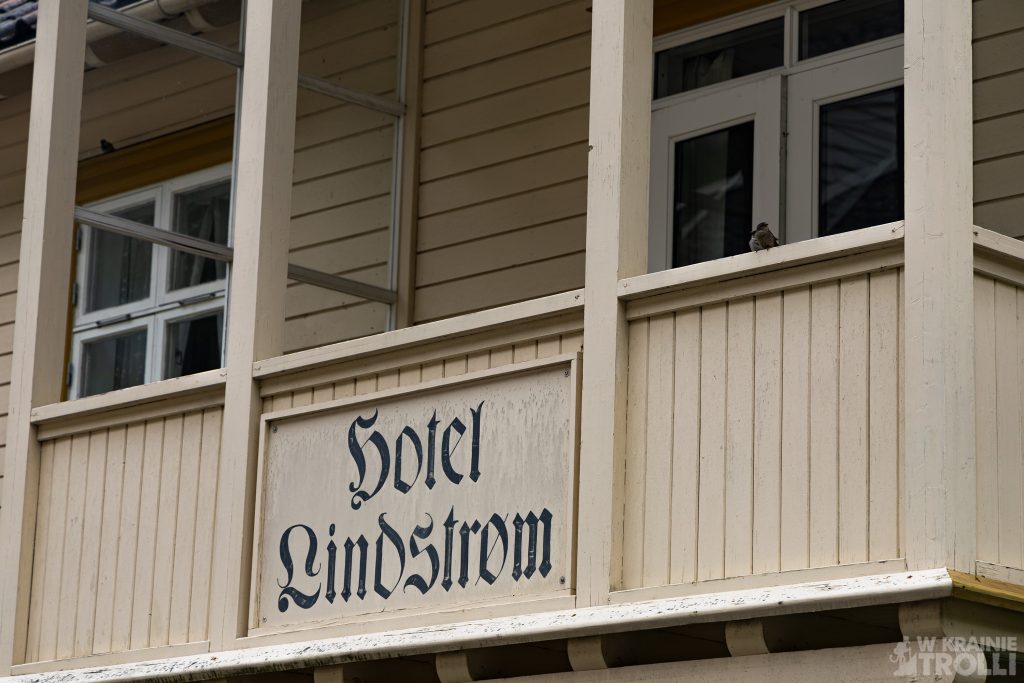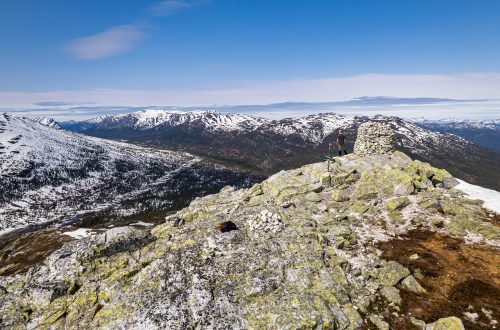
Lærdalsøyri
Dolina Lærdal jest usytuowana w miejscu, gdzie najdłuższy z norweskich fiordów, Sognefjord dociera do swojego najdalszego wschodniego końca. Łączy się on jeszcze z trzema odnogami: Lustrafjordem, ciągnącym się na północ, Årdalsfjordem na wschodzie i Lærdalsfjordem, najkrótszym z całej trójki, zmierzającym na południowy wschód. Na końcu tego ostatniego ma swój początek dolina Lærdal, która ciągnie się aż w okolice Maristovy i Królewskiej Drogi (Kongevegen) przez góry Filefjell. Dolinę łączy się często z historyczną trasą łączącą zachodnią Norwegię z resztą kraju, a w szczególności ze stolicą. Dawniej, gdy sieć dróg i połączeń komunikacyjnych nie była tak rozwinięta, to właśnie głębokie doliny pomiędzy zboczami gór wyznaczały kierunki prowadzenia dróg. Jedna z pierwszych powstała właśnie tutaj.
Lærdalsøyri, miasteczko przycupnięte na końcu Lærdalsfjordu to centrum społeczności żyjącej w dolinie. Dawniej znajdował się tu ośrodek handlu (ponoć największy poza granicami Bergen), czemu trudno się dziwić biorąc pod uwagę położenie na szlaku wschód – zachód. Ślady osadnictwa pochodzą jeszcze ze średniowiecza. Do dziś, zachwyt budzi zabytkowa, drewniana zabudowa miasteczka. W Starym Lærdalsøyri (Gamle Lærdalsøyri), zobaczyć można aż 160 zachowanych z dawnych lat budynków (niektóre nawet z połowy XVIII wieku). Niestety w styczniu 2014 roku w jednym z domów wybuchł pożar, który wraz z podmuchami silnego wiatru rozprzestrzenił się dalej i uszkodził cześć z chronionych zabudowań, a jeden z budynków spłonął całkowicie.
Zabytkowe domki w Gamle Lærdalsøyri nie stoją opuszczone, ale wciąż tętni w nich życie. Mieszczą się w nich sklepy z antykami, wyposażeniem wnętrz, stanowią punkty serwujące lokalną żywność. Znaleźć tu można także dwa przytulne, drewniane hotele: Hotel Lindstrøm, oraz pensjonat Sanden.
Obecnie miasteczko zamieszkuje nieco ponad 1000 osób. Sam spacer po spokojnym, idyllicznym, pełnym uroczych, drewnianych domków Lærdalsøyri to niezwykłe przeżycie. Jeśli kiedyś będziecie w pobliżu, zatrzymajcie się tam na chwilę. W okolicy znajduje się też kilka innych ciekawych atrakcji:
– Kościół słupowy w Borgund (Borgund Stavekirke) z 1180 r., 28 km (20 min jazdy) od centrum Lærdalsøyri. W tym samym miejscu jako część Drogi Królewskiej (Kongevegen) z 1790 roku, przejść można widowiskowe odcinki Vindhellvegen czy Galdane.
– Norweskie Centrum Dzikiego Łososia (The Norwegian Wild Salmon Centre).
– Snøvegen czyli Droga śnieżna (National Scenic Route Aurlandsfjellet), prowadząca przez góry 44 km trasa prowadząca do Aurlandsvangen. Droga ta jest zamknięta między październikiem a kwietniem.
– Najdłuższy na świecie tunel, Lærdalstunnelen, liczący 24,5 km łączący dolinę Lærdal z Aurlandsvangen, trasa alternatywna do wspomnianej powyżej.
– Niepowtarzalny mikroklimat doliny Lærdal, sprawia, że na okolicznych farmach uprawiane są morele, brzoskwinie, maliny czy truskawki.
The Lærdal Valley is situated where Norway’s longest fjord, the Sognefjord, reaches its farthest eastern end. It connects to three more branches there: the Lustrafjorden, which goes north, the Årdalsfjorden in the east, and the Lærdalsfjorden, the shortest of all three, which goes south-east. At the end of the latter is the beginning of the Lærdal valley, which stretches all the way to the vicinity of Maristova and the King’s Road (Kongevegen) through the Filefjell Mountains. The valley is often linked to the historic route connecting western Norway to the rest of the country, especially the capital. In the past, when the network of roads and communication connections was not so developed, it was the deep valleys between the slopes of the mountains that determined the directions of roads. One of the first was established here.
Lærdalsøyri, a town perched at the end of the Lærdalsfjord, is the center of the valley community. In the past, there was a trade center here (the largest one outside Bergen), which is hardly surprising given its location on the east-west route. Traces of settlement come from the Middle Ages. To this day, the historic wooden buildings of the town arouse admiration. In Old Lærdalsøyri (Gamle Lærdalsøyri), you can see about 160 preserved buildings from the old days (some even from the mid-18th century). Unfortunately, in January 2014, a fire broke out in one of the houses, which, together with strong wind gusts, spread further and damaged some of the protected buildings, and one of them burned down completely.
The historic houses in Gamle Lærdalsøyri are not abandoned, but they are still full of life. There are shops with antiques, interior design, and restaurants. There are also two cozy wooden hotels here: Hotel Lindstrøm and Guesthouse Sanden.
Currently, the town is inhabited by just over 1,000 people. Just a walk through the peaceful, idyllic Lærdalsøyri, full of charming wooden houses, is an extraordinary experience. If you’re ever around, stop by for a while. And there are several other interesting attractions in the area:
– Borgund Stavekirke, dating from 1180, 28 km (20 min drive) from the center of Lærdalsøyri. In the same place as part of the Royal Road (Kongevegen) from 1790, you can walk the spectacular sections of Vindhellvegen or Galdane.
– The Norwegian Wild Salmon Centre.
– Snøvegen or Snow Road (National Scenic Route Aurlandsfjellet), a 44 km route through the mountains leading to Aurlandsvangen. This road is closed between October and April.
– The world’s longest tunnel, Lærdalstunnelen, 24.5 km long, connecting the Lærdal valley with Aurlandsvangen, an alternative route to the one mentioned above.
– The unique microclimate of the Lærdal valley causes that apricots, peaches, raspberries and strawberries are grown on the surrounding farms.
















3 komentarze
Lidia Ogrodowczyk
Piękne miasteczko, ale ludzi nie widać.
Lidia Ogrodowczyk
Piękne miasteczko, tylko takie puste. Ludzi nie widać.
Eugeniusz
Pięknie. A po obejrzeniu powyższego ludzi może być więcej 🙂